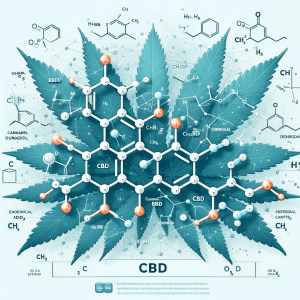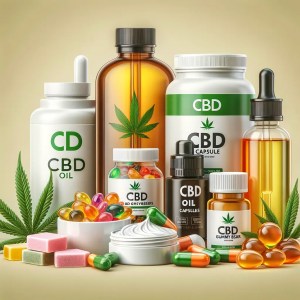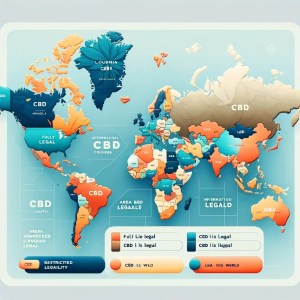- Introduction to CBD
- CBD in Modern Medicine: A Journey Through Time
- CBD Laws: An International Perspective
- Therapeutic Uses of CBD: An Evidence-Based Guide
- Understanding the Safety Profile of CBD
- Incorporating CBD into Daily Life
- FAQs About CBD
- 1. What is CBD and How Does it Work?
- 2. Is CBD Legal?
- 3. What are the Health Benefits of CBD?
- 4. Can CBD Make You High?
- 5. Are There Side Effects of Using CBD?
- 6. How Can I Take CBD?
- 7. How Much CBD Should I Take?
- 8. Can I Use CBD for My Pet?
- 9. How Long Does it Take for CBD to Work?
- 10. Can CBD Be Addictive?
- 11. How Should I Store CBD Products?
- 12. How Do I Choose a High-Quality CBD Product?
- 13. Can I Travel with CBD?
- 14. Does CBD Show Up on Drug Tests?
- Conclusion: Understanding and Embracing the Potential of CBD
Introduction to CBD
CBD, or cannabidiol, has recently emerged as a significant trend in the wellness industry, offering an array of potential health benefits without the psychoactive effects often associated with marijuana. This article provides a comprehensive understanding of CBD, including its types, uses, and legal aspects.
Understanding CBD: Definition and Origin
Cannabidiol, commonly known as CBD, is a naturally occurring compound found in Cannabis sativa plants, including hemp and marijuana. Unlike its cousin THC (tetrahydrocannabinol), CBD does not induce a ‘high’. Discovered in 1940, CBD is one of over 113 identified cannabinoids in cannabis plants, accounting for up to 40% of the plant’s extract. It’s important to note that calling the medicine ‘CBD’ is somewhat recent. Historically, the cannabis plant itself has been used in various traditional medicine practices, but the specific identification and isolation of CBD and its many cannabinoids only occurred in relatively recent history.

The Science Behind CBD: How It Works in the Body
CBD works by interacting with the body’s endocannabinoid system (ECS), a complex network that regulates various physiological processes such as pain, inflammation, mood, sleep, and digestion. Unlike THC, which primarily interacts with CB1 receptors linked to the psychoactive effects, CBD intercepts both CB1 and CB2 receptors in the ECS. This interaction confers various therapeutic effects without inducing a high. CBD exerts its effects through multiple molecular pathways, affecting more than 65 molecular targets, including serotonin receptors for anxiety and depression, vanilloid receptors for pain and inflammation, and GPR55 orphan receptors involved in bone reabsorption and cancer cell proliferation.
Ancient Uses of CBD: A Historical Overview
The history of CBD is closely intertwined with the use of the cannabis plant. The earliest recorded use of cannabis for therapeutic purposes dates back to 2737 BC in China, where Emperor Cheng Neng brewed a CBD-infused tea to treat ailments like gout, malaria, and rheumatism. Throughout history, cannabis has been utilized for its medicinal properties in various cultures around the world. This includes treatments for digestive and nutritional disorders, nervous system and mental disorders, and pain and inflammation, paralleling the findings of modern science.
CBD in Modern Medicine: A Journey Through Time
The recognition of CBD’s potential in modern medicine marks a significant shift from its historical uses. Groundbreaking research and novel applications are evidence of contemporary science’s embrace of CBD.
Contemporary Recognition and Research
- CBD’s Medical Breakthroughs:
- Clinical Trials and Studies:

Different Types of CBD: Full Spectrum, Broad Spectrum, Isolate
CBD products are available in different forms, each with unique characteristics and benefits:
- Full Spectrum CBD:
- Contains all cannabinoids found in the cannabis plant, including THC. The presence of multiple cannabinoids leads to the ‘entourage effect,’ where compounds work synergistically to enhance therapeutic effects.
- Broad Spectrum CBD:
- Includes most cannabinoids from the cannabis plant but typically lacks THC. This form is suitable for users looking to benefit from the entourage effect without THC’s psychoactive effects.
- CBD Isolate:
- The purest form of CBD, free from other cannabinoids, terpenes, and plant materials. This is ideal for those who need high doses of CBD or who must avoid THC for legal or personal reasons.
Forms of CBD: Oils, Edibles, Topicals, and More
The versatility of CBD is evident in the variety of product forms available:
- CBD Oils and Tinctures:
- Commonly used for their versatility and ease of dosing. They can be taken sublingually, added to food or beverages, or applied topically.
- Edibles:
- Such as gummies, chocolates, and baked goods offer a discreet and convenient way to consume CBD. The effects of edibles are usually delayed but prolonged compared to other forms.
- Topicals:
- Including creams, balms, and lotions, are applied directly to the skin for localized relief from pain and inflammation. They are popular for their non-psychoactive effects.
- Capsules and Pills:
- Provide a precise and easy way to consume CBD, especially for those who prefer a tasteless option.
- Vaping Products:
- Offer a quick onset of effects as CBD is inhaled directly into the lungs. However, concerns about the safety of vaping have led to caution among users and health professionals.
The integration of CBD into modern medicine reflects a blend of historical knowledge and contemporary scientific validation. With ongoing research and a growing product market, CBD’s role in healthcare and wellness is evolving, promising more targeted and effective applications in the future. As the industry grows, understanding the different types of CBD and their respective forms becomes crucial for both consumers and healthcare providers.
CBD Laws: An International Perspective
The legal landscape of CBD is as diverse as it is complex, varying significantly from one country to another. Understanding these laws is crucial for consumers, producers, and distributors of CBD products.

Global Variation in CBD Legality
- United States:
- European Union:
- Most EU countries allow CBD derived from hemp, provided it contains less than 0.2% THC. However, regulations can vary, with some countries having more restrictive policies.
- Canada:
- Cannabis, including CBD, was legalized for recreational and medicinal use in 2018. CBD products are widely available and regulated by the government.
- Australia and New Zealand:
- In Australia, CBD is legal but heavily regulated and primarily available via prescription. New Zealand recently made steps towards legalizing CBD for medical purposes.
- Asia:
- The legal status of CBD in Asian countries varies widely, with some countries having strict anti-cannabis laws, while others, like Thailand, have started to relax regulations for medical use.
- Latin America:
- Countries like Mexico and Uruguay have made significant strides in legalizing and regulating cannabis, including CBD, mainly for medical purposes.
Legal Challenges and Progress in CBD Legislation
- Regulatory Challenges:
- One of the major challenges is the classification of CBD – whether as a controlled substance, a prescription drug, or a wellness supplement. This impacts its accessibility and research.
- Recent Developments:
- Countries like the United States and Canada have made significant progress in legalizing and regulating CBD, setting precedents for other countries.
- Future Prospects:
- The global trend indicates a gradual move towards the legalization and regulation of CBD, especially for medical purposes. However, the pace of change varies, and international agreements and standards are still in development.
- Impact of Legalization:
- Legalization has led to increased research, better quality control, and the development of new CBD-based products. However, it also brings challenges like ensuring product safety and preventing misuse.
The international perspective on CBD laws highlights a fragmented and evolving legal landscape. With ongoing changes and developments in legislation, understanding and navigating these laws is crucial for anyone involved in the CBD industry. As research continues to uncover the potential benefits of CBD, it is likely that more countries will revisit and potentially revise their stance on cannabis and CBD legislation.

Therapeutic Uses of CBD: An Evidence-Based Guide
Cannabidiol (CBD) has garnered significant interest for its potential therapeutic properties. This segment examines the scientific evidence supporting the effectiveness of CBD in treating various health conditions.
Evidence for Therapeutic Efficacy
- Epilepsy:
- Anxiety and Mental Health Disorders:
- Pain and Inflammation:
- Substance Use Disorders and PTSD:
- Other Disorders:
CBD for Chronic Conditions: What Research Says
Many people turn to CBD for relief from chronic health issues. Research into CBD’s efficacy in managing chronic conditions reveals promising but not yet definitive results:
- Chronic Pain:
- Neurodegenerative Diseases:
- Autoimmune Diseases and Inflammation:
While the therapeutic potential of CBD is supported by a growing body of research, particularly in the treatment of epilepsy, much remains to be studied and proven in other areas. The effectiveness of CBD in treating various conditions often comes with mixed evidence, necessitating further well-designed clinical trials. It’s also crucial to consider the quality and source of CBD products, as regulatory oversight varies. As research continues to evolve, so too will our understanding of CBD’s role in treating various health conditions.
Understanding the Safety Profile of CBD
While CBD is generally considered safe, it’s important to understand its safety profile, potential risks, and side effects associated with its use.
Potential Risks and Side Effects of CBD
- Common Side Effects:
- Drug Interactions:
- CBD can interact with other medications, such as blood thinners. It’s essential to consult with a healthcare provider before combining CBD with other medications.
- Quality and Purity Concerns:
- Long-term Effects:

Managing Side Effects and Interactions of CBD
- Consultation with Healthcare Providers:
- Before using CBD, especially if taking other medications or having underlying health conditions, consulting with a healthcare provider is crucial.
- Starting with Low Doses:
- Begin with lower doses of CBD and gradually increase as needed, monitoring for any adverse effects.
- Being Aware of THC Content:
- Some CBD products may inadvertently contain THC, leading to psychoactive effects and other adverse events. It’s important to verify the THC content in CBD products.
Criteria for Selecting High-Quality CBD Products
- Third-Party Testing:
- Look for products that have undergone independent third-party testing. This testing can provide verification of the product’s CBD content and purity.
- Transparent Labeling:
- Choose products with clear, accurate labeling, including the amount of CBD per serving, a full ingredient list, and the manufacturer’s information.
- Source of Hemp:
- Consider the source of the hemp used in CBD products. Hemp grown in countries with stringent agricultural regulations is generally of higher quality.
Spotting Fake or Low-Quality CBD: Tips and Tricks
- Suspiciously Low Prices:
- Be wary of products priced significantly lower than similar options on the market, as this can indicate inferior quality.
- Lack of Information:
- Avoid products from companies that do not provide detailed product information or refuse to share third-party test results.
- Unrealistic Health Claims:
- Steer clear of products making extravagant health claims that seem too good to be true.
- Research the Brand:
- Conduct thorough research on the brand, including reviews and customer feedback, to gauge the product’s reliability.
Understanding the safety profile of CBD is crucial for its safe and effective use. While CBD is generally well-tolerated, being aware of its potential side effects, interactions with other medications, and the importance of choosing high-quality products is vital for consumers. As the CBD market continues to grow, consumers should remain informed and cautious to ensure the best possible experience with CBD products.

Incorporating CBD into Daily Life
Integrating CBD into daily routines can be a seamless way to enjoy its potential benefits for wellness. This section explores various methods to include CBD in everyday life effectively.
Morning Rituals with CBD
- CBD Capsules with Supplements:
- CBD in Beverages:
Fitness and Recovery
- Pre- or Post-Workout:
- Topical Applications:














